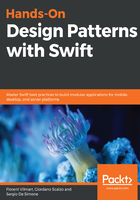
Type aliases
Type aliases are a simple addition to the language; they let you reference simple or complex types by an alias. They support all declarations that you can imagine, from the simplest to the most complex.
The following block contains declarations for aliasing the following:
- A string class into a MyString
- A function declaration into a Block
- A block that takes any argument and returns any value
- A block that takes no argument and returns any value
Let's see the code block; they let you:
typealias MyString = String
typealias Block = () -> Void
typealias TypedBlock<T, U> = (T) -> U
typealias ReturningBlock<U> = () -> U
We could have also defined Block in the function of ReturningBlock:
typealias Block = ReturningBlock<()>
You can also use type aliases for protocol compositions and complex types, as follows:
- You can declare a type that conforms to a protocol and is of a particular class
- You can delete a type that conforms to multiple protocols
Let's see an example, as follows:
protocol SomeProtocol {}
protocol OtherProtocol {}
typealias ViewControllerProtocol = NSViewController & SomeProtocol
typealias BothProtocols = SomeProtocol & OtherProtocol
You will often find yourself using type aliases, in order to make your code more readable and more expressive. They are a powerful tool for hiding away some of the implementation complexity or verbosity when declaring long conformances. With type aliases, you can be encouraged to craft many protocols, each with a very small requirement list; then, you can compose all of those protocols when you need them, expressed as those types.